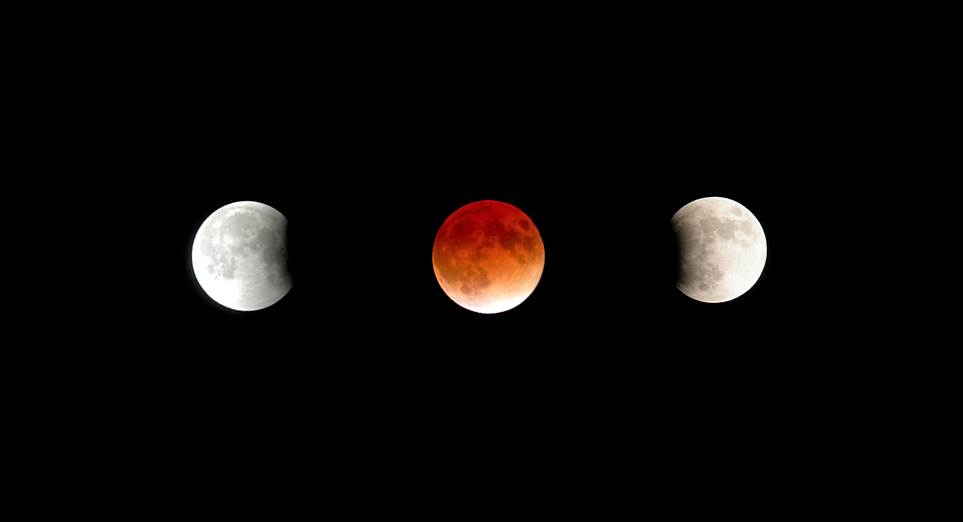In the early morning hours of Election Day 2022, as most of the country is still asleep, a rare celestial event will be taking place.
A total lunar eclipse, popularly known as a “Blood Moon” for the red-orange color seen during the event, is set to fill the sky from about 4 a.m. to 6:41 a.m. the morning of Nov. 8. According to NASA, this eclipse will be the last total lunar eclipse for three years, with the next occurring on March 14, 2025.
A lunar eclipse occurs when the Sun, Earth, and Moon align so that the Moon passes into Earth’s shadow, according to NASA.
“The reddish or brownish-orange tinge of the lunar surface seen during totality is caused by the solar rays refracting through the earth’s atmosphere, much like we see spectacular red sunsets at night,” said Gary Boyle, astronomy educator and columnist for the Royal Astronomical Society of Canada. “This amazing sky show will play out with Eastern, Atlantic and Newfoundland time zones seeing most of the event until moonset. The rest of North America will enjoy the late but spectacular show. This is a very safe event as the full Beaver moon (full moon for November) will pass through the earth’s shadow for a maximum of three hours and forty minutes.”
Here is a rough timeline of when the event will begin across the Eastern Time Zone, provided by Boyle.
- Partial umbral eclipse begins | 4:09 a.m. | Moon enters the earth’s shadow.
- Total lunar eclipse begins | 5:16 a.m. | Moon turns dark orange or red.
- Greatest eclipse | 5:59 a.m. | Mid-point of the eclipse.
- Total lunar eclipse ends | 6:41 a.m. | Moon begins to leave the shadow as it sets in the west.
- Partial umbral eclipse ends | Moon ready set.
Mythology
For thousands of years, different cultures have attributed meaning to the “Blood Moon” total lunar eclipse.
According to a National Geographic article on eclipse superstitions, the ancient Inca people believed the Blood Moon was red because of a ravenous Jaguar that attacked and ate the moon.
David Dearborn, a researcher at the Lawrence Livermore National Laboratory in California, told National Geographic the Inca feared that after the Jaguar attacked the moon, it would come to earth and Earth to eat people, so they would try to drive the predator away by shaking spears at the moon and making their dogs to howl and bark.
In the bible, there are two blood moon references, both saying nearly the same thing:
- “The sun shall be turned into darkness, and the moon into blood, before the great and terrible day of the Lord,” – Joel 2:31
- “The sun shall be turned into darkness, and the moon into blood, before the great and notable day of the Lord.” – Acts 2:20
Christian preachers John Hagee and Mark Blitz promoted an apocalyptic belief known as the “blood moon prophecy,” highlighting a lunar sequence of four total eclipses that occurred in 2014 and 2015.
Not all cultures view an eclipse as a bad thing, however. Jarita Holbrook, a cultural astronomer at the University of the Western Cape in Bellville, South Africa, said in a 2013 interview that her favorite myth comes from the Batammaliba people in West Africa, according to the National Geographic article. They believe, she said, the sun and the moon are fighting during an eclipse, and the people encourage them to stop.
“They see it as a time of coming together and resolving old feuds and anger,” Holbrook said. “It’s a myth that has held to this day.”
Daniel Brown, a lecturer in Astronomy at Nottingham Trent University in England, wrote in 2018 that in Islamic cultures, eclipses tend to be interpreted without superstition, and he believes that is how everyone should see the event.
“Rather than awaiting doom and destruction, we can better view it along the lines of the Islamic interpretation – as a monumental illustration of the fascinating and real motions of our solar system,” he writes. “So my suggestion is this: watch the lunar eclipse as how the sky unfolds above you. Give it your own name, give it your own meaning, and enjoy it with your friends and family. And I think you’ll find that the term “blood moon” cannot do justice to the wonder of what you’re watching.”
(Images provided by Gary Boyle)






